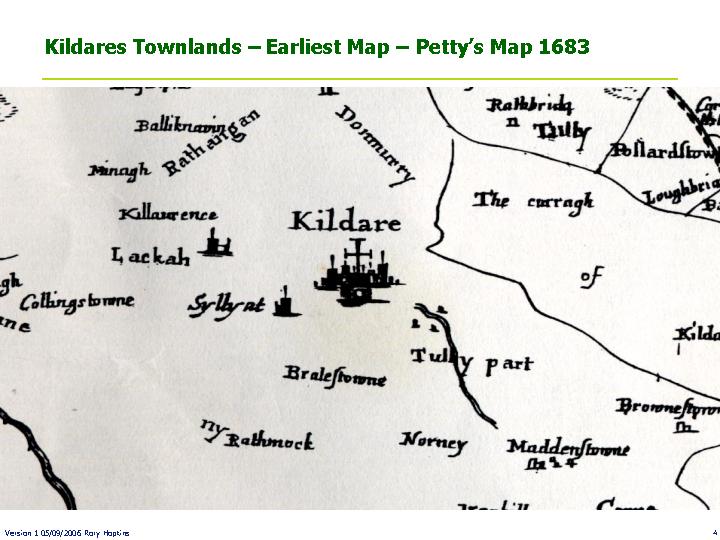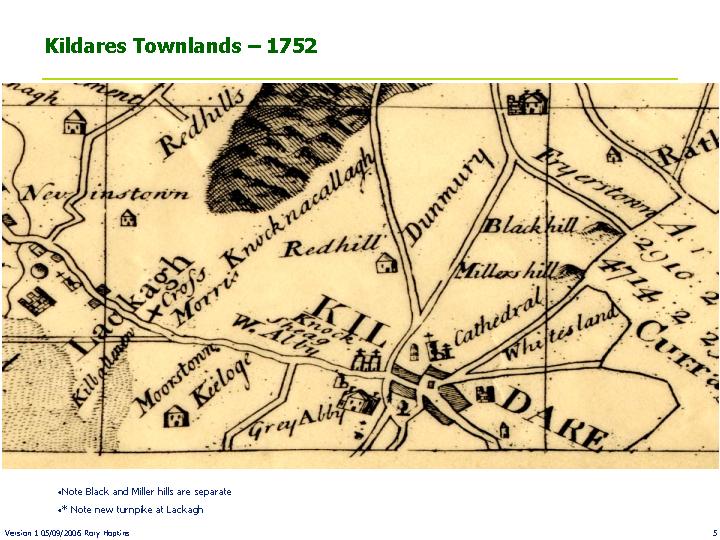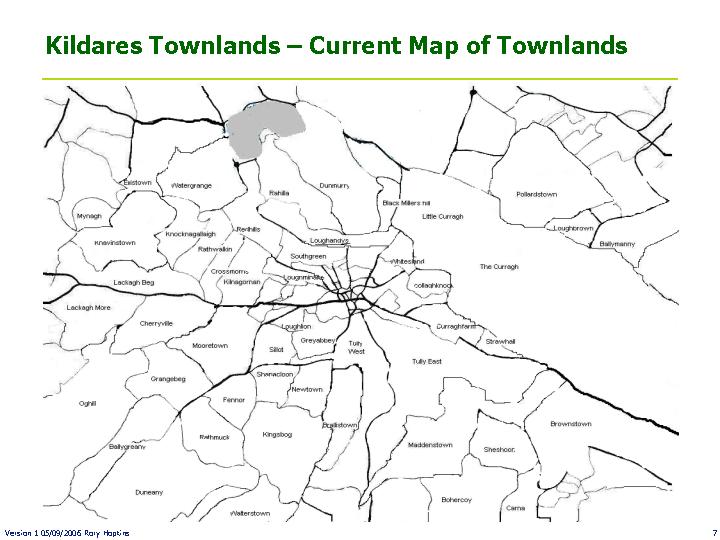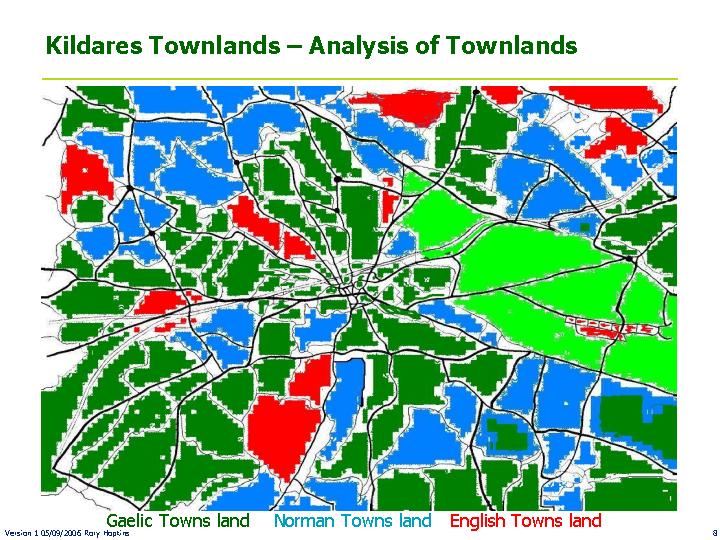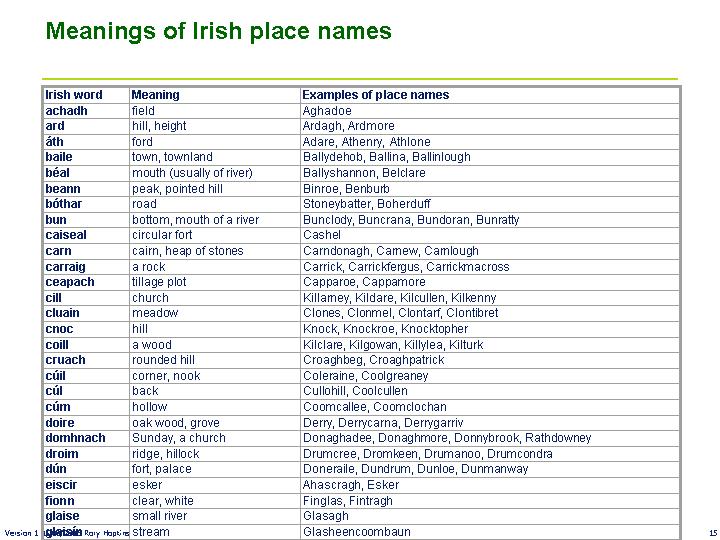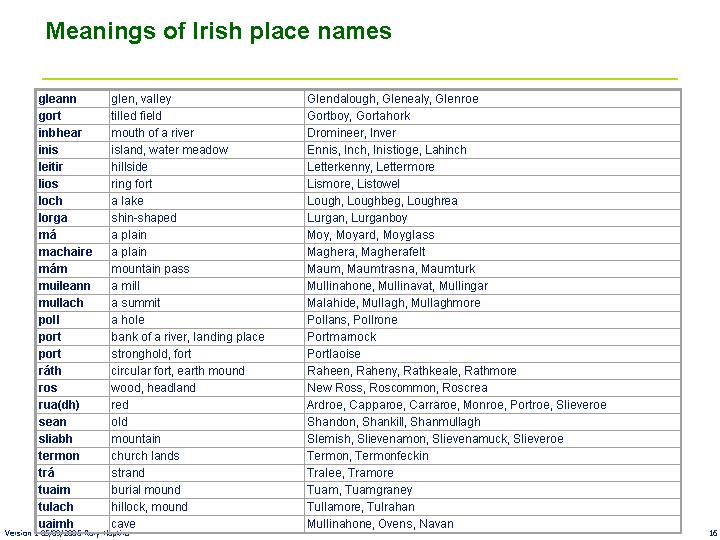« October 2006 |
Main
| December 2006 »
November 27, 2006
Kildare Town Heritage Centre
KILDARE HERITAGE CENTRE
Mario Corrigan and Mary Stones
The Kildare Town Heritage Centre is an exciting visitor attraction situated in the picturesque town of Kildare. The centre is an ideal point of departure from which to explore the ancient treasures of the town. It is housed in the restored and refurbished nineteenth century Market House, which is situated in the hub of Kildare town. This unique historic building, with its vista of windows, designed to oversee the market place, has been given a new lease of life and is an impressive addition to the heritage assets of the town. The Heritage Centre was formally opened on the 17th September 2001 by the then Minister for Finance and T.D. Mr. Charlie McCreevy.
The building has a long and varied history. According to the Statutes of Henry VI (1458) a market had been held in Kildare ‘from time whereof memory runs not,’ and an official weekly market, to be held on Thursdays, was authorised by Henry VIII in the Charter of Kildare of 1515. A survey of the Earl of Kildare’s estate in the town by Emerson in 1674 mentions a town hall but not a Market House. Since the location of the Town Hall cannot be determined we might suggest it was situated here, centrally in what became the Market Square and the focus of activity in the town. Reference to the ‘Market Place’ can be found in the Registry of Deeds Office in 1726 and 1751 and although the recognisable triangular area of the modern ‘Square’ is unnamed in John Rocque’s Map of Kildare of 1757 it was designated the Market Square’ in Thomas Sherrard’s Map of Kildare of 1798 and subsequent maps.
Rocque however does identify ‘The Markett house,’ in the centre of what is later known as the Market Square on the site of the modern Heritage Centre. According to Rocque it consisted of three adjoining buildings with a yard in 1757. If we accept Emerson made no mention of a Market House in 1674 because it did not exist then the Market House was built sometime between 1674 and 1757 (however he may not have mentioned it because it was not part of the Earl of Kildare’s estate, or because the town hall and market place fulfilled the same function at that stage. By 1798 (Sherrard) it had developed into a singular rectangular building on the same site with another section to the Cathedral or western side. This projection had disappeared by 1817 but a small northern (facing Nugent Street/Station Road) projection could be noticed on the 1838 Ordnance Survey Map of the town. Interestingly a well was noted by Rocque in 1757 to the east (Dublin side) of the Market House, a pump in 1817 and a fountain in 1838; presumably referring to the same feature, a water source for the town’s inhabitants. A pump was used on the Market Square until the early 20th century but was eventually removed. In 1973 an ancient well was discovered on the Market Square but filled in for safety reasons. It was re-discovered in 2003 and, now restored, has become a permanent feature on the Market Square.
According to Niall Meagher, former Co. Architect, while it may have incorporated an earlier structure, the present building dates from the nineteenth century. In 1838 the Market House was clearly identified as a public building. Valued at £5 in 1844, it was exempt from rates. Not only was the Market Square a centre of economic activity it provided a space/forum for town gatherings and meetings. This was captured by the ‘Illustrated London News’ on the 8 January 1881 in a drawing of a Land League Meeting, with the Market House in the background, showing leases of the Duke of Leinster being burned on the end of a ‘98 pike. Originally it may have been a single storey building but by the mid-nineteenth century at least it had been re-developed with an upper level. By the mid-1880’s a water tank had been placed in the roof of the Market House as a receptacle for water being pumped from St. John’s Well at Tully.
By the mid-twentieth century the Market House had fallen into disrepair and was bought for £300 by Kildare Co. Council. It was carefully reconstructed in the early 1970’s and a bus shelter, public toilets and small museum were incorporated into the new building. The cast-iron water gauge dated 1885 was retained on the outside of the building as was a plaque celebrating the completion of the Kildare Waterworks in 1886. It won an An Taisce Award in 1973 because of the improvement it made to the appearance of the town.
A Heritage project Committee representing the three second-level schools was formed in 1992 to campaign for Heritage Status for the Town of Kildare. The designation of Heritage Town provided an impetus for the reinvigoration of the Market House. The European Development Fund provided £230,000 towards the project with additional funding coming from Kildare County Council (£50,000) and local contributions. Once building began the reconstruction and refurbishment took a little less than 2 years and Kildare Town Heritage Centre was officially unveiled in September 2001.
The Heritage Centre contains a multi-media exhibition centre telling the story of Kildare, past and present, combining attractive fixed panels with a video trail where your host Cogitosus, a 7th century monk will take you on a historic journey from the time when St. Brigid established her church in 480. A.D. This video presentation lasts approximately 12 minutes. The visitor can catch a fascinating glimpse of the past before visiting the many other attractions, which include the Japanese Gardens, the Grand Canal the National Stud and the Curragh racecourse. The Centre is the Tourist Office for local and county-wide tourist information, a place where tourists can book accommodation or purchase a golf passport. It also has a vibrant shop where visitors can purchase souvenirs and jewellery.
An article from the Grey Abbey Conservation Project's new book CHURCH OF THE OAK, on the Heritage Centre - the old Market House.
Posted by mariocorrigan at 09:55 PM
The Knights Hospitallers at Tully
The Knights Hospitallers and the foundation of
The Black Abbey at Tully
Mario Corrigan
According to Lewis’s Topographical Dictionary the civil parish in 1837 comprised 1600 statute acres (as rated for the county cess) and some 4,800 acres of bog adjoining the Curragh, with some 20 different townships or places paying tithes to the Bishop. In the sixteenth century, as well as the immediate demesne lands of Tully, there were rectories at Tully, Doneany, Rathbride and Calverston, as well as lands in Moortown, Friarstown, Brallistown and other areas even further afield. The extent of these holdings can generally be attributed to the granting of lands at Tully to the Knights Hospitallers, or Knights of the Order of St. John of Jerusalem, in the 13th century. The name, however, ‘Tully,’ which has many variations, comes from the Gaelic ‘Tullach’ meaning ‘hill’ or ‘rising ground’ and some historians suggest that this may have been the site of an even older Irish monastery called ‘Tulach Fobhair’ (discounted by Thomas O’Connor in the Ordnance Survey letters). It is the Hospitallers, however, who built the Black Abbey.
The Hospitallers
The Crusades saw the rise of the Military Orders of the Knights Templars and the Knights Hospitallers of St. John of Jerusalem. The earliest known reference to the Order of Knights Hospitallers occurs in 1113, when the papal privilege of Pope Paschal II was addressed to – Gerard establisher and commander of the Jerusalem hospice, though it was surely in operation prior to this date. Initially the function of the newly formed brotherhood, a purely peaceful one, was to provide for the pilgrims to the Holy Land. This hospitality earned generous donations of land and money in Europe particularly from grateful pilgrims on their return to their homes. Eventually the Order evolved into those brothers or brethren who fought, mounted Knights, and the lay brethren who cared for the sick and performed religious duties. The Hospitallers wore a black cloak with a white cross to distinguish them from the Templars who wore a white cloak with a red cross. In 1259 the pope approved the adoption of the rectangular Jerusalem Cross to be worn on the Knights battle-dress (over their armour) while at other times, as they carried out their primary duties, the 8 pointed cross, signifying the eight beatitudes, would be worn. The Order grew remarkably in strength and were in possession of at least 7 strongholds including the formidable Crac de Chevaliers. With the fall of Jerusalem in 1187 their position radically changed and finally with the fall of Acre in 1291 they were driven from the Holy Land.
From here they went to Cyprus but in the early 14th century they concentrated their forces on Rhodes and established their headquarters there in 1310. Here they built of an extensive fleet and helped escort pilgrims by sea to the Holy Land. Indeed, from 1309-1522 they were known as the Knights of Rhodes. The Order was greatly enriched by the suppression of the Templars by papal decree in 1312 (Holinshead dates it to 1308). Throughout the 14th and 15th centuries the Hospitallers continued to defend Rhodes from the Muslim advance, particularly after the fall of Constantinople in 1453, and famously triumphed in the sieges of Rhodes in 1460 and 1480. It was a time also of administrative change and the Order was divided into eight langues or tongues. They were forced to withdraw from Rhodes after the siege of 1522. In 1530 Charles V granted them the island of Malta and throughout the 16th and 17th centuries they remained a crusading force taking part in the capture of Tunis in 1535, Great Siege of Malta May – September 1565, the battle of Lepanto in 1571, the attack on Algiers in 1644 and the defence of Oran in 1707. Now known as the Knights of Malta, they were to remain there until 1798 when the island was surrendered to Napoleon.
Hospitallers in England
The Order was established in England around 1144 and the Grand Priory was established at Clerkenwell. The Order spread to establish some 37 precertories with some 120 Knights and various other brothers and sergeants. English Knights of the Order did go to the Crusades and some even took part in the last great siege of Rhodes in 1522. The Order was suppressed in England by Henry VIII in early 1540 and while a few knights were executed as martyrs, others left for Malta. In 1557 the Order was re-established by Queen Mary but afterwards suppressed by Queen Elizabeth. Titular priors continued to be appointed by the Grand Master of the Order.
Hospitallers in Ireland
The Knights Hospitallers were introduced to Ireland with the Norman invasion. They were first established at Wexford around 1172 and the Grand Priory at Kilmainham was established in Dublin around 1174 by Strongbow, Richard de Clare, Earl of Pembroke. In 1212 Pope Innocent III confirmed some 129 properties acquired by the Order in Ireland. While they spread rapidly in terms of increasing property the membership of the Order was more circumscribed than the monastic and mendicant orders because of its very nature and recruitment base. Postulant knights had to have proofs of nobility, pay a large fee, maintain himself and 2 horses, travel on call and when they died all their property and possessions was to be bequeathed to the Order. There may have only ever been 30-40 or so actual Knights of the Order if we consider that they established in the region of 17-19 preceptories (figures vary).
In Ireland as elsewhere the brethren had to maintain their primary duty to provide hospitality to pilgrims and travellers, but because of the troublesome nature of the country in the wake of the Norman invasion the preceptories very often acted as military outposts on the borders of the Anglo-Norman territories such as at Killybeggs and Kilteel in Co. Kildare.
The last Prior of Kilmainham was Sir John Rawson, appointed in 1511. With the advent of the suppression of the monasteries and religious houses Rawson began (1538) to let Hospitaller territories at low rents on long leases with pension obligations (for the brethren). The beneficiaries were invariably members of his own family, political allies and some of the senior Knights of the Order. Rawson negotiated the surrender of Kilmainham and the properties of the Order in 1540. He was eventually raised to the Peerage as Viscount Clontarf, with the lands of the preceptory of Clontarf and a substantial pension. The voluntary nature of the handover was given special significance in the act for the suppression of Kilmainham and other houses in 1542. In reality this was the end of the Order in Ireland although titular priors were appointed right up to the mid 19th century.
Hospitallers in County Kildare
The Kinights Hospitallers established three preceptories in County Kildare – at Killybegs, near Prosperous; Kilteel or Kilheale, near Rathmore and at Tully, near Kildare. These can be found amongst the 6 or sites identified as eventual sites of preceptories in the properties confirmed by the Pope in 1212. Killybegs and Kilteel particularly were founded on the borders of Anglo-Norman territory and as such were as much military outposts as they were hospices for travellers. Kilteel at least was an important juncture protecting the Pale from the O’Tooles and O’Byrnes of Wicklow. It was founded around 1220 by Maurice FitzGerald, 2nd Baron of Offaly, and was essentially a fortified stronghold which could also fulfil the primary role of the Order by providing hospitality. It was leased to Thomas Alen, brother of the Lord Chancellor, for £17 in 1540. Killybegs was leased to Gerald Sutton and passed into the possession of David and Edward Sutton his executors. The other great Kildare preceptory of the Order County Kildare was that of Tully, near Kildare Town.
Hospitallers at Tully.
There is no date for the foundation of the Hospitaller Preceptory at Tully and there is some doubt as to who the founder was. After the Norman invasion Kildare Town was part of Strongbow’s (Richard de Clare, Earl of Pembroke) holdings and after his death in 1176 it passed to William Marshall who married his daughter and heiress Isabella in 1189 (Strongbow’s immediate successor was Gilbert, a minor, who died around 1185). Marshall received a new grant of Leinster in 1208 and died in 1219, so if Tully was one of the 129 properties (property meaning a chapel and some surrounding lands with possibly other buildings) confirmed in 1212 by Pope Innocent III then the initial grant of Tully was given to the Hospitallers either by Strongbow or William Marshall, and pre-dates 1212.
With the death of the last of the male line of the Marshall family in 1245, the lordship of Leinster was divided amongst 5 heiresses. Kildare (county) was the share of Sybil Marshall, wife of William de Ferrers but by the time of the division of the inheritance Sybil was dead and her share was to be divided amongst her 7 daughters. The castle and manor of Kildare however remained the possession of Margaret, Countess of Lincoln, widow of Walter Marshall as part of her dowry for the next twenty years. Margaret died around 1270 when the liberty of Kildare (and the castle and manor of Kildare Town) came into the possession of Agnes de Vesci (a daughter of Sybil de Ferrers). On her death it passed to her son William de Vescy who came to Ireland in November 1290 as Justiciar (1290-1294). He surrendered it to the Crown in 1297 and had it returned for life but he died that same year and it reverted to the Crown.
In terms of the preceptory at Tully since we do not know the date of the actual establishment then it is difficult to say with any certainty who is responsible for its foundation. There is almost no reference to Tully from the time of the papal confirmation of 1212 until October 1290, at which time it appears that Geoffry de Siwaldeby was Master of Tully. This pre-dates the arrival of de Vescy and also suggests it was in existence for a time previous to that date.
There is very little in any of the histories on Kildare Town for the period from 1247-1270 and yet Maurice FitzGerald is accredited, in different sources, with the establishment of Grey Abbey and the Preceptory at Tully. Surely the endowment could only come from the lord of the manor and in the examination of the matter of the dowry of de Vescy’s wife, Isabella, in 1297 the manor of Tholy (Tully) was clearly part of de Vescy property and presumably before that it was held by the Marshall family. Therefore it is reasonable to assume that the property was not FitzGerald’s to give.
What escapes us is the actual date for the foundation of the preceptory. As we have seen a chapel and some land etc. at Tully was confirmed by Pope Innocent III to the Hospitallers in 1212. This was shortly after the arrival of William Marshall in Ireland around 1207 but in fact may even have been granted by Strongbow. The problem remains that the actual preceptory is not mentioned until the 1290’s. Kildare was an important religious and political centre and a strategic outpost against the O’Connor Falighe and the O’Dempseys of Glanmalire. A preceptory of Knights Hospitallers would have been an important part of the defensive mechanism employed within the County. There is a similar dearth of information of the other houses but Kilteel is presumed to have been founded by Maurice FitzGerald around 1220 and it seems likely that Tully is of similar date. Even if the lands were already in the hands of the Hospitallers by the time of his succession to the lordship of Leinster in 1189, surely Marshall would have made maximum use of the Order as a military presence on the edge of the county town considering he was soon to re-develop and fortify the earlier castle of Kildare, established by Strongbow. As a Crsuader to the Holy Land he would have been well acquainted not only with the hospitality of the Order but their usefulness as a military force in a besieged land. This might suggest a date for the establishment of the Preceptory of the Knights Hospitallers at Tully prior to his death in 1219.
An article from the Grey Abbey Conservation Project's new book, CHURCH OF THE OAK, on the foundation of the Black Abbey at Tully.
Posted by mariocorrigan at 09:30 PM
CHURCH OF THE OAK - Book Launch
CHURCH OF THE OAK
BOOK LAUNCH
The Grey Abbey Conservation project launched their book, 'Church of the Oak; a contribution to the history of Kildare Town,' in Aras Bhride, the Kildare Town Parish Centre on Friday 24th November, at .8 p.m.
The book was launched by the Mayor of Kildare, Councillor Fionnuala Dukes and is the first comprehensive contribution to the history of Kildare Town in over 50 years.
Compiled and edited by Mario Corrigan and Ger Kelly it is published by The Grey Abbey Conservation Project.
As well as the excellent 'Short History of Kildare Town,' by Mark McLoughlin, the book contains over 20 well researched articles on subjects such as
St. Brigid
Kildare, the Monastic City
The Norman Invasion
The Abbeys of Kildare
The Fitzgeralds
The 1798 Rebellion and the Gibbet Rath Massacre
Poverty in Kildare
The Military in Kildare
The Coffee House and the Racing Lodges
The National Stud – the first 50 years
The creation of the Japanese Gardens
Recollections of Hospital Street and Blind Lane
Kildare during the Irish Civil War – 1922
The Market House – Kildare Town Heritage Centre
There are more than 70 interesting articles from the Kildare Observer and the Leinster Leader from 1880 – 1979 – a wide range of items that made the headlines over 100 years with over 200 captioned photographs of over 1500 people, at numerous social, sporting and workplace events and venues
All proceeds will go to The Grey Abbey Conservation Project.
There was a large turnout on the night and the book was very well received by all who attended.
The Grey Abbey Conservation Project would like to thank all those who made it possible, the contributors and those who who generously donated their photographs. We are extremely grateful for the generous support of KELT without which the book could never have been published and indeed the financial support of the people of Kildare Town at the annual Church Gate Collection.
We would also like to acknowledge the continued support of FAS and the CE scheme and Kildare County Council.
To mark the launch I will add some of the articles from CHURCH OF THE OAK to the site.
The Grey Abbey Conservation Project have launched their contribution to the history of Kildare Town, entitled CHURCH OF THE OAK
Posted by mariocorrigan at 09:30 PM
November 21, 2006
1907 - Talbot's Bull in Boland's Bar!!
Leinster Leader Saturday 17 August 1907, p.5.
In Kildare
…
The bull who amused himself in a china shop is always with us, but it is something new to find a bullock making a sudden dash for a drapery establishment, calmyl hesitating at the door and in a moment or two, after a survey, entering the premises. On Tuesday last a fine bullock purchased from Mr. James Logan by Mr. Patrick Talbot, Kildare, was being driven to the victualler’s premises of the latter, and evidently thinking that it should see a new phase of life before final sentence was passed, it made a side move and went in a hard gallop towards Mr. Boland’s premises in the Square.
* * *
Stopping suddenly at the door, it coolly walked in through the drapery department and caused no little consternation. However, it evidently did not find what it was looking for, and proceeded towards the bar premises, where it is alleged against the unfortunate beast that he surreptitiously got through more liquid refreshment than he was able to pay for. Sentence of death has been pronounced by Mr. Talbot and there is no immediate prospect of a reprieve.
* * *
The well-known licensed and general business premises of Mr. Edward M’Cormack, Kildare, have been bought over, or rather bought in, for Mr. M’Cormack during the past week. The sum paid is the substantial one of ₤2,210, and we are glad to see that Mr. M’Cormack will still carry on the business as usual in his own name and right.
* * *
It will be remembered that Mr. M’Cormack, who is one of the most popular business men in the county, had a few weeks ago to seek protection of the court, and the estate is now bought in for Mr. M’Cormack, we are glad to see, by a fellow-townsman. During the time of arrangement, and preliminary to the order of sale, Mr. J. J. Sherlock, officer of the courts, assisted Mr. M’Cormack in every possible way. Mr. Sherlock has the happy knack of making himself popular while attending to his duties.
A highly amusing story in the Leinster Leader of August 1907.
Posted by mariocorrigan at 12:02 AM
November 14, 2006
COUNTY KILDARE RARE BOOKS FAIR
Local Studies, Genealogy and Archives, Kildare County Library and Arts Service,
in association with
Lyonshill Books, presents
THE FIRST EVER CO. KILDARE
RARE BOOKS FAIR
KILDARE TOWN 1 p.m. – 5 p.m.
SUNDAY 19 NOVEMBER 2006
ALL WELCOME - NO COVER CHARGE - 3 VENUES
KILDARE TOWN HERITAGE CENTRE; KILDARE TOWN PARISH CENTRE AND THE FOYER OF EUROSPAR
THOUSANDS AND THOUSANDS OF BOOKS, RARE, ANTIQUARIAN AND LOTS OF BARGAINS And FREE VALUATIONS !!!
History, local, national, literature, poetry, sport, fiction and ephemera.
Why not take the opportunity to visit Kildare Town – ST. BRIGID’S CATHEDRAL, THE JAPANESE GARDENS, KILDARE HERITAGE CENTRE and the fantastic new
KILDARE OUTLET VILLAGE.
The three venues are
Foyer of Eurospar - on main street (Claregate Street) - has underground parking
Heritage Centre- Market House Market Square - parking on the Market Square and also Nugent Street (north of Market Square towards the Railway Station) beside the playground - pedestrian access back to Market Square
Parish Centre or ARAS BHRIDE - beside RC Church on St. Brigid's Square - parking on St. Brigid's Square
Also Parking in Kildare Outlet Village - easily accessed from motorway - pedestrian access to Kildare Town across boardwalk at Grey Abbey (Franciscan ruin) straight to St. Brigid's Square
There will be a map at each venue and sandwich boards outside each venue to direct people.
M7 from Portlaoise direction - slip road to Kildare - left at roundabout - right at next roundabout to Kildare Outlet Village or straight through to lights - turn right straight through to Kildare Town Centre - Eurospar on left and Marhet House/Heritage Centre on Square
M7 from Dublin - slip road to Kildare at end of Curragh (not Newbridge exit) 2 ways - (1) left at roundabout and immediate left again to St. Brigid's Square - Parish Centre; (2) right at roundabout and across the bridge then straight through next roundabout to Kildare Outlet Village or straight through to lights - turn right straight through to Kildare Town Centre - Eurospar on left and Market House/Heritage Centre on Square
From Athy - Booleigh Cross - Nurney - Newtown Cross and Old Nurney Road - 2 ways - (1) right to St. Brigid's Square - Parish Centre; (2) straight through at 1st roundabout and across the bridge then straight through next roundabout to Kildare Outlet Village or straight through to lights - turn right straight through to Kildare Town Centre - Eurospar on left and Market House/Heritage Centre on Square
Details and directions to County Kildare Rare Books Fair, Sunday 19th November, Kildare Town.
Posted by mariocorrigan at 02:27 PM
November 08, 2006
CIVIL WAR MONUMENT CLEANED UP
The Civil War Monument erected by the National Graves Association in 1940 at Grey Abbey has been beautifully restored to its former glory. The surrounds have also been cleaned and chippings added to the grave to complete the restoration. The work was finished last week by Annette Emerson from Laois. She was engaged by Matt Doyle of the National Graves Association after being contacted by the Grey Abbey Conservation Project regarding the condition of the grave earlier this year. The National Graves Association paid for the restoration of the monument and the cleanup of the grave and earlier this year co-funded, with Kildare Tidy Towns, the restoration of the railings around the civil war monument on the Market Square. They hope to have a small ceremony in December 2006 in Kildare Town in honour of the men executed in 1922 and to mark the work done this year.
The Grey Abbey Conservation Project would like to gratefully thank them for their efforts and their commitment to their work, not just in Kildare but throughout the country.
The monument was erected to commemorate the seven I.R.A. Volunteers executed at the Curragh on the 18 December 1922. Their bodies were initially buried at the Curragh but they were re-interred in Grey Abbey in 1924. A moument was erected on the Market Square in 1935 and another at Grey Abbey in 1940 to mark the grave.
Photos from 12 April 2004
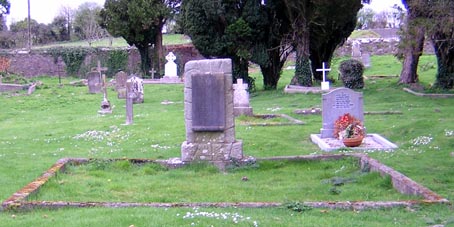
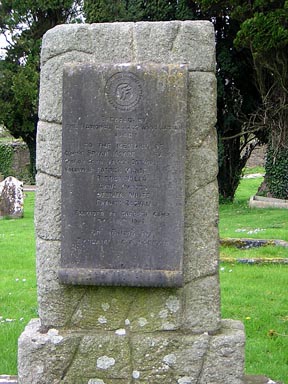
Photos from Monday 6 November 2006
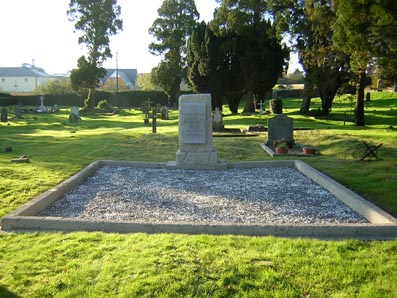
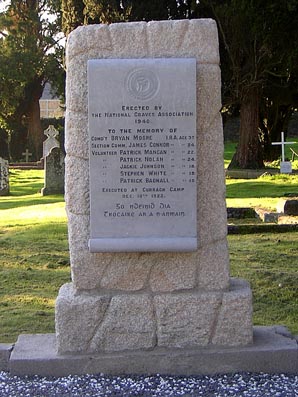
The Civil War Monument at Grey Abbey has been restored by the National Graves Association
Posted by mariocorrigan at 12:28 AM
November 03, 2006
County Kildare Rare Books Fair Sunday 19/11/2006
Local Studies, Genealogy and Archives
Kildare County Library and Arts Service
in association with
Lyonshill Books
presents
THE FIRST EVER CO. KILDARE
RARE BOOKS FAIR
KILDARE TOWN
1 p.m. – 5 p.m.
SUNDAY 19 NOVEMBER 2006
All welcome
No cover charge
KILDARE TOWN HERITAGE CENTRE; KILDARE TOWN PARISH CENTRE AND THE FOYER OF EUROSPAR
Please support this event so we might ultimately make it an Annual Local History and Heritage Event!
THOUSANDS AND THOUSANDS OF BOOKS, RARE ,ANTIQUARIAN AND LOTS OF BARGAINS And FREE VALUATIONS !!!
History, local, national, literature, poetry, sport, fiction and ephemera.
Why not take the opportunity to visit Kildare Town – ST. BRIGID’S CATHEDRAL, THE JAPANESE GARDENS, KILDARE HERITAGE CENTRE and the fantastic new
KILDARE OUTLET VILLAGE.
MAKE AN AFTERNOON OF IT!
More info:- Mario Corrigan PH 087-9871046 (Tues to Sat) – Email:- localhistory@kildarecoco.ie
Eddie Murphy PH 087-2567908 Email:-lyonshillbooks@eircom.net
AN HISTORIC FIRST!
The first ever County Kildare Book Fair will take place on Sunday afternoon on the 19 November in Kildare Town. This will be an opportunity for those interested in Local History and heritage as well as the general population who are interested in books and reading in general to visit a Rare Books Fair outside of Dublin. It is being organised by the Local Studies, Genealogy and Archives Department of Kildare County Library and Arts Service in conjunction with Kildare County Council and Lyonshill Books. According to Local Studies Librarian, Mario Corrigan, "there is an enormous interest in Dublin and other areas in this sort of event and it is about time we in County Kildare had the opportunity to have one locally. It is an ideal opportunity also for anyone who has not yet visited the new Kildare Retail Outlet Village to come to the town and see what is on offer."
The event is free and open to all and will allow people to browse the books on offer in the three different venues - The kildare Heritage Centre, The Kildare Parish Centre and the foyer of the Eurospar Shopping Centre. "The idea behind the three venues is to encourage people to walk through Kildare Town and thoroughly enjoy the day," said Mario Corrigan who has recently published a Sli na Slainte and Heritage Trail of Kildare Town and is anxious that people enjoy the experience that Kildare, the Heritage Town, has to offer.
Eddie Murphy of Lyonshill Books is delighted to be able to add County Kildare to a growing list of Book Fairs that he and his colleagues have orchestrated. "It is an immensely pleasurable experience, whereby people can browse the stalls and hopefully with this new initiative in Kildare Town take in some of the rich heritage of such an historic setting - maybe pause in the local shops or the local cafes and pubs for a coffee and even visit the Outlet Village for a unique shopping experience. We do hope this proves to be successful and we can turn it into an annual event," said Mr. Murphy.
So why not take an afternoon break on Sunday 19 November and come to Kildare Town to the County's first Rare Books Fair - maybe in search of a unique Christmas gift or just to amble through the historic streets and enjoy the experience. Currently there is an exhibition of Kildare artists, a collaboration between the Outlet Village and Riverbank Arts Centre, on view in the Kildare Outlet Village and Kildare Town Heritage Centre has a host of collectibles and gift ideas to wet you appetite.
As well as book dealers The Kildare Archaeological Society, Kildare Federation of Local History Groups, the Grey Abbey Conservation project and Cill Dara Historical Society will hopefully have information on their organisations and activities on display for people to view. All in all it is an ideal day out and most importantly - it's free.
The first County Kildare Rare Books Fair will take place on Sunday 19 November.
Posted by mariocorrigan at 09:54 PM
THE RORY HOPKINS LECTURE ON KILDARE'S TOWNLANDS
KILDARE’S TOWNLANDS
by
Rory Hopkins
Kildares Townlands - Guide To Irish Land Division
Province –Leinster. In 300 BC, Labhradh Loingseach brought an army of Gauls from France to assist him in recovering the kingdom from his uncle. These foreign soldiers used a kind of broad pointed spear, called laighen [layen]; and from this circumstance the province in which they settled, which had previously borne the name of Galian, was afterwards called Laighen, which is its present Irish name. The termination `ster', which has been added to the names of three of the provinces, is the Scandinavian or Danish stadr, a place. Laighien-ster (the place or province of Laighen) would be pronounced Laynster, which is the very name given in a state paper of 1515, and which naturally settled into the present form, Leinster.
County –Kildare was "shired" by King John Lackland of England in 1210 creating an Anglo-Norman territory to be administered for the crown by the Earls of Kildare.
Barony – East Offaly – The name was derived from Ross Failghe the eldest son of Cathaoir Mor, King of Ireland A.D. 122-125. Ireland was divided into 273 baronies. They were composed of a larger number of townlands than a parish and are said to be an ancient form of administrative unit used for the collection of taxes etc
Civil Parish – East Offaly comprises the parishs Ballymany, Ballysax, Ballyshannon, Concurry, Dunmurry, Grangeclare, Kildare, Kilmeague, Lullymore, Pollardstown, Rathangan, Thomastown & Tully
Towns land - A townland is one of the smallest land divisions in Ireland. There are over 60,000 of them and they range in size from an acre or two up to many thousands of acres. The majority are in the hundreds of acres
Kildares Townlands
“The Townland system is considered to be one of the most distinguishing marks of Ireland and the term townland itself, while unknown in the homeland of the English language is recognised in all parts of Ireland” (O Maolfababhail 1978)
“Townland names like the landscape to which they relate are precious records of the history, legends and mythology of their communities” (Loughrey 1986)
Kildares Townlands – Preamble
Up to 95% of townlands whose names include and a ‘Family name’ followed by
‘Town’ are of Anglo-Norman origin examples of such names are Pollardstown,
Crotanstown, Walshestown, Brownstown and Maddenstown also area’s
with the word Grange which refers to Church land are of Norman
origin. For the purposes of this discussion I will concentrate on the Gaelic
names. I will also include the earliest owner of the land and one owner/tenant
from Griffiths valuation from 1851 if possible.
Gaelic Towns land Norman Towns land English Towns land
Kildares Townlands
The Curragh – Place of horse racing, The word cuirreach means a racecourse. The ancient name of Cuirreach Lifé shows that long ago the original plain reached that river’s banks, but since Anglo-Norman times it has been gradually encroached upon from all sides. The Curragh lay in the ancient territory of Magh Lifé, or Lifé’s plain, so called from Lifé, daughter of Mac Druchta, cup-bearer to Conaire Mór, King of Eire. Hence Abhann Lifé, or the River Lifé, running through Magh Lifé which was situated in the O’Byrne territory of Offelan.
Kildare (Cill Dara) - Church of the Oak
Drumcree (Dromcriadh) - ridge of clay
Tully – The little hill (a rising ground) THE KNIGHTS HOSPITALLERS who lived at Tully were monk soldiers organised to assist pilgrims on their way to the Holy Land and to protect the Places sacred to Christians which were in danger from the Mahommedan Infidels. Their first foundation was a hopsice in Jerusalem.The ensign of the order was a white flag with a black cross. Hence the Abbey was called ‘The Black Abbey.’ Owner 1641 Peter Sarsfield, Landowner/Tenant 1851 : Michael Conway
Botharcoy (Bothar Bui) – The Yellow road
Carna - monument of stones
Kildares Townlands
GreyAbbey -THE GREY ABBEY has its name from the grey habit worn by the Franciscan Friars. Lord William de Vesci built the monastery for the Friars in 1260. Later the lands of Kildare passed to John Fitzthomas and so to the Earls of Kildare. The monastery was suppressed about 1543 and its lands and buildings and valuables confiscated and granted to Daniel Sutton. Some of their property seems to have been overlooked, for in 1589 the remainder was confiscated. Owner 1641 Peter Sarsfield. Landowner 1851 Patrick Lee
Shanacloon – The old meadow (lands belonged to Franciscans 1260) Ballyshannon Naas?
New Town – Typically associated as plantation or post plantation towns (Not mentioned in 1641) Tenant 1851 Philip & Patrick Hopkins
Silliot (Sillagh) – The place of the Sally’s (willows). Owner Peter Sarsfield. Landowner/Tenant 1851 Thomas Heffernan
Fennor (Fionnabhair) – White field. Owner 1641 Maurice Fitzgerald. Landowner/Tenant 1851 John Dunne
Rathmuck – The fort of the pig. Owner 1641 Maurice Fitzgerald. Landowner/Tenant 1851 Martin Kelly
Grange beg - Little Grange 1851 James Behan
Ballygreany – The town of the sandy or gravely place. Owner 1641 Maurice Fitzgerald, Landowner/Tenant 1851 Edward O’Farrell
Kildares Townlands
Oghill – place of Yew wood - Landowner/Tenant 1851 John Hyland
Cross Maurice - 1520AD Battle of Crossmaurice. Maurice FitzGearld killed by the O'Mores of Leix. A cross marked the spot where he was killed.1851 Thomas Fitzgerald
Lackagh – A place full of stones or flags. Owner 1641 James Fitzgerald, Landowner/Tenant 1851 Patrick Fitzgerald
Mynah - Little plain
Knocknagalliagh (Cnoc na gCailleach) – The hill of the nuns. 1641 owner John White. Landowner/Tenant 1851 Maurice Dooney
Knockshough – Hawk hill Landowner/Tenant 1851 Thomas Patterson
Grangeclare (Grainseach an chlair) – Grange of the Plain – outlying farm belonging to Hospital of St. John. Owner 1641 Charles Lord Moore, Landowner/Tenant 1851 Timothy Whelan
Loughminane (Lochminane) - the formation of which is thus accounted for in the Feilire Aenguis in the Leabhar Breac: “Eighteen bishops came to Brigid to Loch Lemnachta, beside Kildare to the north. So Brigid asked her cook whether she had food, and she said she had none. And Brigid was embarrassed, so the angel said the cows should be milked again. And Brigid milked them, and they filled the tubs, and they would have filled all the vessels of Leinster, and the milk came over the vessels, and made a loch thereof. Hence the name Loch Lemnachta, lake of New Milk.” Landowner/Tenant 1851 Mary Cleary
Kildares Townlands
Rathbride – fort of Brigid (common around Ireland associated with places Brigid visited). Owner 1641 John Lye, Landowner 1851
Crockanure (Cnoc-an-iubhair) – The hill of the yew tree
Fearann Dearg (not Bearg)–The red ploughed field
Cloghgerret –The stone (or stone castle) of Garret? Owner/Tenant 1851 Hugh Conlan
Collaghknock – The land at the back of the hill Landowner/Tenant 1851 Patrick Connolly
Rathangan (Rath Iomghain) – Iomgan Rath
Dunmurry – Murray’s Fort, Taxation value 1303 six marks, nine shillings. Owner 1641 Earl Of Kildare, Landowner 1851 Edward Medlicott
Red Hills –“from the redness of the earth I suppose. There is a copper mine here said to be very rich, which is working these three years past, not with that spirit however which can only render undertakings of the kind of public importance.” - TOPHAM Bowden 1790
Carrigin Earle – The Earl’s Castle. Owner 1641 Earl of Kildare
Pollardstown- From the french surname for head (Value of 50 shillings in 1303)
Ballymany (Baile Meadhonach) – Middle Town
Kildares Townlands – The ones that got away!
Kilnagornan – The wood of the black smiths?
Loughandys – The lake of the swamp?
Loughlion – The lake of the children?
Duneany – Fort of the swamp ?
Rathwalkin – Fort of Walkin ?
Monasterevin Townlands
Townlands in the Civil Parish of Monasterevin
The Townland in a Medieval and older territorial division based on a number of plough lands. In later times they formed the basis for rental assessments. The following is a list of townlands, their Irish name and meaning.
Ballyfarsoon: Baile an pearsan. Town of the Parson.
Barraderra: Baire a doire. Top of the oak wood.
Clogheen: Cloicin. A small stone or stone house (possibly St. Evin's bell house or oratory).
Cloncarlin: Cluain Caireallain. Carolan's Meadow (also called Globe Island).
Clonegath: Cluain na gath. Meadow of the spears (possibly meaning battlefield).
Cowpasture: Possibly a commonage area.
Coolnefearagh: Cuail na Fearagh. The men's corner or grassy corner (a place of assembly).
Fearmore: Fiair Mor. Great Meadow.
Gorteen: Guirtin. A small garden or cultivated field.
Gorteenoona: From the same root as Gorteen.
Grangecoor: An out farm of the Cistercian monastery.
Kill: Cill or Coill. A church or wood.
Kilpatrick: Cill Pádraig. St. Patrick's Church.
Larchhill: A hill with a plantation of larch trees ? Does anyone have an Irish name for the area?
Lughill: Liamh Coill. Elm Wood
Millfarm
Monasterevin: Manistir Eimhin. The Monastery of Evin.
Monasterevin Bog: The Bog of the Monastery of Evin
Moore Abbey:Originally called The House of Monasterevan.
Oghill: Eochaill. Yew Wood.
Oldgrange: The old grange or out farm of the Cistercian monastery.
Passlands: Possibly the land of the pass, associated with the Pass Bridge.
Skirteen: Scairtin. A little cluster of bushes or a thicket.
Stramillian
Toghereen: The Little Causeway (tracks over bogs dating to the Late Bronze Age are known throughout the area of Monasterevin).
Notes from the recent excellent lecture on the derivation of townland names delivered by Rory Hopkins to the Cill Dara Historical Society in September.
Posted by mariocorrigan at 09:12 PM


